Our September 2021 issue featured two double-action 44 Magnum revolvers that we thought were extremely well suited for personal defense. We tested an older S&W Model 29 against a brand-new Taurus Model 44. We thought the Taurus had a lot to offer, but so did the Smith & Wesson, and we found very real differences in the production of two pistols manufactured almost 50 years apart. Once again, we have two different 44-caliber revolvers to test and contrast for you, but these were designed for a different purpose. They are long-barreled, hunting-style, single-action revolvers. Big ones.
The first is a 7.5-inch-barrel Ruger Super Blackhawk 1976 Bicentennial Model, $660. The current version of this pistol is the company’s Model 0802 with an MSRP of $829. The second is also a 7.5-inch-barrel Ruger Super Blackhawk, but this is the Bisley Hunter Model 0862, MSRP $1149) made some 45 years later. Factory ammo is still very difficult to obtain, but we have been loading for this caliber for a couple of decades, so we were able to concoct some very good ammo for our Rugers.
Loads tested were the 240-grain hard-cast Keith-style semi-wadcutter from Hunter’s Supply (MidwayUSA.com 267313, $53/250) loaded both as 44 Special and 44 Magnum cartridges, along with the 240-grain Speer Gold Dot Jacketed soft point (MidwayUSA.com 166262, $25.49/100). Loads were assembled using a mix of brass, Winchester large pistol primers, VihtaVuori N110 or Alliant 2400 powder and recipes from the Lyman 50th Edition Reloading Handbook.
All shooting was done at American Shooting Centers (AMShootcenters.com) in west Houston. Accuracy was tested at 15 yards by shooting multiple five-shot groups from a well-sandbagged Caldwell Pistolero shooting rest (MidwayUSA.com 517357, $28). Velocities were obtained using a LabRadar chronograph (MyLabRadar.com, $559). Speed tests were conducted using multiple runs consisting of five rounds fired at a 9-inch white plate at 10 yards. Here are our results and impressions:
Gun Tests Grade: A-
$660
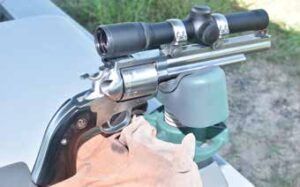
Few firearms are as iconically American as the 1873 Colt Single Action Army (SAA). “The gun that won the West” (though some would argue that was really the 1873 Winchester rifle) was a staple of the Colt product line until WWII required Colt to focus on military production. Colt did not resume production of the SAA until 1956 and, by then, there was a new kid on their block by the name of Bill Ruger. Mr. Ruger designed the now famous Mark 1 semi-auto in his garage, introducing it in 1949. His 22-caliber redesign of the basic single action hit the market in 1953 and Sturm, Ruger & Co. has never looked back. Ruger used less labor, modern production methods, good cast parts, and coil springs to correct some of the design weaknesses of the SAA. The net effect was a great gun at an affordable price. The Single Six was up-chambered and released as the Blackhawk in 1955. Sold in 357 Magnum, the Blackhawk was a simple, strong design that sold well. Once Mr. Ruger learned about the new 44 Magnum from Smith & Wesson, he further strengthened the Blackhawk, creating a larger frame that was capable of handling the 44 Magnum. This became known as the Super Blackhawk, and S&W had some real competition on their hands.
Ruger Super Blackhawk 44 Magnum
The Pachmayr grips helped hold onto the pistol in movement, almost a bit too well. The adhesion of the grips had our hands a bit sore by the time we finished all of the testing.| Action Type | Revolver, single action only |
| Overall Length | 13.75 in. |
| Overall Height | 6.0 in. |
| Maximum Width | 1.73 in. |
| Weight Unloaded | 2.9 lbs. |
| Weight Loaded | 3.2 lbs. |
| Receiver Material | Carbon steel |
| Finish | Blued |
| Front Strap Height | 2.3 in. |
| Back Strap Height | 4.25 in. |
| Barrel Length | 7.5 in. |
| Grip Thickness (Maximum) | 1.3 in. |
| Grip Circumference | 5.2 in. |
| Cylinder Capacity | 6 rounds |
| Rear Sight | Adjustable |
| Front Sight | Fixed ramp |
| Sight Radius | 9.5 in. |
| Trigger-Pull Weight | 3.1 lbs. |
| Trigger Span | 3.6 in. |
| Safety | Hammer bar |
| Warranty | None written |
| Telephone | (336) 949-5200 |
| Website | Ruger.com |
| Made In | USA |
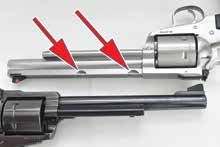
Westerns were all the rave on the TV then, and the Super Blackhawk was more readily available as well as less expensive than the S&W Model 29. Score another one for Bill Ruger. The New Model Blackhawks were introduced in 1973 and changed the way the revolver operated. No longer would the Blackhawk (or Super Blackhawk) have to be placed on half-cock to load and unload. No longer would the firing pin rest on a primer. Now the Blackhawk family could be carried with all six chambers loaded due to a transfer bar safety system being installed. The Super Blackhawks can easily be recognized by the more-pointed back edge of the trigger guard and the unfluted cylinder. Our sample was built shortly after these last design improvements went into production. It is a commemorative for America’s 200th birthday in 1976 and, as such, shows a few extra flourishes. This may be a commemorative, but it was designated a shooter a long time ago.
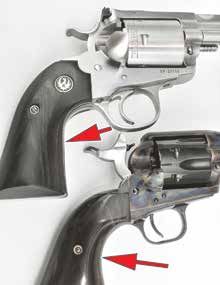
Though some 45 years old as of this writing, this Super Blackhawk has held up remarkably well. At one point, there was a bit of surface rust on the sides of the hammer, but that cleaned up well. There are light marks on the cylinder showing that this Ruger has been cocked many times. The sides of the muzzle show just a bit of holster wear. We’re not sure what happened to the original wood grips, but the Pachmayr grips now installed did well for us, giving us a bit more to hold onto and protecting the knuckle on our middle fingers a little. The only repair we’ve had to make was replacing the base pin and latch, which were somewhat loose. Ruger took care of that for us without any fuss.
Now available in both stainless steel and blued finishes with 4.62-, 5.5-, 7.5-, and 10.5-inch barrels, this Bicentennial Model had the 7.5-inch tube. The rear sight is adjustable for windage and elevation. The front sight is a serrated black ramp. The rear sight does not have any white outline, nor the front sight any kind of colored insert or paint. This is precisely the arrangement we preferred — when we were a bit younger. Now, we find that we like a red ramp a lot.
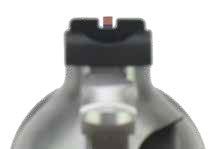
The longer barrel also means that the ejector rod is plenty long enough to make sure empties are pushed completely from the cylinder. There is a transverse latch at the cylinder end of the base pin. To remove, open the loading gate and, looking from the rear to the muzzle, depress the latch from left to right. At the same time, pull forward on the base pin (wiggle it a little or rotate the cylinder by hand as you go). The pin will come out and the cylinder can then be extracted from the right side of the frame.
We measured the unfluted cylinder at about 1.70 inches in length. We found that gave us plenty of room to chamber just about anything we would want to shoot. There was still a fair amount of space left, even with some long 320-grain hard-cast bullets loaded. Those unfluted walls on the cylinder mean that the Super Blackhawk should have plenty of strength to stand up to any reasonable loads we need to use. The barrel is not a thin profile, but is not particularly thick either. This model does not have any kind of underlug or full rib over the barrel. With full-house loads, recoil is a bit snappy.
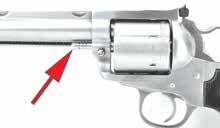
While not the easiest version to transport, we think the 7.5-inch barrel provides an outstanding compromise of portability, sight radius, and power. We looked back at our speed-trial times of the double-action 44s tested in the September 2021 issue. The Super Blackhawk was a bit slower, but not much, and was a good bit more accurate with that longer barrel.
Our Team Said: Still rock solid after 45 years of use, this Ruger Super Blackhawk is a keeper. When we were shooting it sans scope, we actually liked the hammer on this version a bit better — it was easier to find and manipulate in the speed drills.
Gun Tests Grade: A
$1149
Early Colt revolvers, specifically the Paterson and Walker models, were marvelous advances in firearms technology. Especially with the 1847 Walker version, lawmen (the Texas Rangers provided much of the impetus for its development) and people on the frontier now had a usable, hand-held, repeating firearm. Considering that the Walker tipped the scales at about 4.5 pounds, they were a bit heavy to carry on the hip. We’ve read stories about Rangers carrying four or five revolvers as they went out to fight Comanches. But not on their bodies. The handguns were usually hanging off the saddle horn or via some other contrivance — hence the term “Horse Pistol.”
Ruger Bisley Hunter 0862 44 Magnum
The recoil impulse on the Bisley model was more comfortable than the standard Super Blackhawk and it was notice-ably more pleasant to shoot. Our middle fingers on the shooting hands were actually in pretty good shape even after several hundred rounds through the Bisley.| Action Type | Revolver, single action only |
| Overall Length | 13.0 in. |
| Overall Height | 6.0 in. |
| Maximum Width | 1.73 in. |
| Weight Unloaded | 3.4 lbs. |
| Weight Loaded | 3.7 lbs. |
| Receiver Material | Stainless steel |
| Finish | Brushed stainless |
| Front Strap Height | 2.3 in. |
| Back Strap Height | 4.25 in. |
| Barrel Length | 7.5 in. |
| Grip Thickness (Maximum) | 1.47 in. |
| Grip Circumference | 5.0 in. |
| Cylinder Capacity | 6 rounds |
| Rear Sight | Adjustable |
| Front Sight | Fixed ramp with red insert |
| Sight Radius | 9.25 in. |
| Trigger-Pull Weight | 2.6 lbs. |
| Trigger Span | 3.0 in. |
| Safety | Hammer bar |
| Warranty | None written |
| Telephone | (336) 949-5200 |
| Website | Ruger.com |
| Made In | USA |
Colt redesigned the frame a few years later to something much more easily carried. This 36-caliber revolver became known as the 1851 Navy because of the scene from a naval battle etched on the cylinder. It was reputed to be the favorite of Wild Bill Hickok and many others. The next major revision is now known as the 1860 Army. It featured a longer grip frame and was a bit larger, allowing the use of 44-caliber balls.
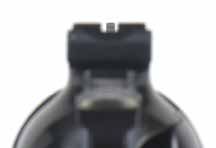
With the 1873 Model P, otherwise known as the Peacemaker, Colt reverted to a frame much more reminiscent of the 1851 Navy. That is still the grip pattern used on most Single Action Army revolvers to this day. The frame feels good in the hand, as long as you don’t mind the little finger hanging below the grips. Modern versions tend to smack the middle knuckle of the middle finger when this type of pistol is chambered in the harder-kicking calibers, such as the 44 Mag. Modifications like the Pachmayr grips on our vintage Super Blackhawk help attenuate the recoil a bit. And then there were further modifications to the grip.
The United Kingdom actually permitted citizens to own firearms and even shoot them at one point in time. The British Rifle Association maintained ranges about 30 miles southwest of London, near the town of Bisley, where they held matches for the growing sport of target shooting. The frame our Bisley Hunters uses was developed during the 1890s in direct response to requests from those competing in the sport. The frame reminds us of the 1860 Army frame crossed with something — we’re not exactly sure what. The Bisley uses the longer grip frame of the 1860 Army, but the back strap is a bit more vertical and the bottom rear tip has been shortened as well. The front strap on our version is much more vertical than the original Bisley and hangs well in the hand. The frame is cut a bit higher behind the trigger guard and takes the shooter’s knuckle slightly further to the rear. The trigger is wider than on our Colt Model P, and the hammer has been reshaped and lowered, making it much easier to cock with the ball of the thumb. There were other changes in the original Bisley with different springs and locations for frame screws. Even with all the changes, many items such as the barrel, cylinder, and ejector rod were still interchangeable between the two models.
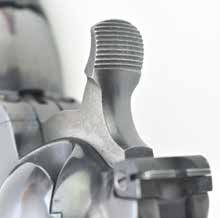
Our Ruger Bisley adds a few more improvements. The grip panels are a dark grey/black laminate that look great on the stainless-steel revolver. Where several of the 44s this group has tested have seemed narrow and tended to put a decent amount of force into a very slim region in the hand, the Bisley went wide on the back strap. The grips extend to a softly rounded edge on the back strap proper and serve to make rear of the Ruger wider, thus spreading out impact from recoil. The steel portion of the back strap is smooth. The cumulative effect is a serious revolver that rolls in the hand a bit more than other frames instead of being directed straight back into the hand.
The top end of the Bisley offers the shooter even more options. We see the adjustable rear sight we would expect along with a removable front sight. Depress the spring-loaded plug just above the muzzle and you can replace it with your choice of several sights available from Ruger, Brownells, and MidwayUSA. The front sight sits atop a full-length rib that adds rigidity and weight to the Ruger. It also provides a location for the 1-inch scope rings Ruger includes with the Bisley Hunter. We mounted a Burris 2.75x Extended Eye Relief scope on the Bisley and shot that as well. Shooting results for both iron sights and the scope were very good.

Be aware of your scope selection if you intend to mount one on the Bisley. Even with the rear sight lowered as far as it could go, the Burris 2.75x EER scope barely fit with the rings provided. When mounted, the ocular bell almost touches the rear-sight blade. We also don’t think that presents a problem, however, because Ruger sells higher rings on Ruger.com. We really like the versatility that a variable-powered scope could bring to this platform. Still, we would also like to see some ingenious mind develop a Picatinny rail mount that could fit in the Ruger slots. We felt the scope was outstanding for still hunting, but we also would like the option to put a red dot on the Bisley in case we couldn’t be quite as stable in our position or were engaging something on the run.
Our Team Said: Our testing criteria places some extra value on versatility. The 45-year-old Super Blackhawk is an excellent handgun that we would not hesitate to buy or carry. Remember that a brand-new model of the Super Blackhawk is currently available. However, the Bisley Hunter, with the extra weight, wider grips, and easily-mounted optics, brings some very important benefits to the table. We’d pay the extra money to get the Bisley.
Galco Kodiak Hunter Holster
The Bisley may be softer to shoot that the regular Super Blackhawk, but it is also heavier. With a scope mounted, it presents a challenge to carry afield comfortably. We tend to put pistols on our strong-side hip when we head for the woods. That can interfere with your day pack. It can also force you to carry your rifle slung on your support-side shoulder. By the time we factor in the scope and rings, the hunter now has about 4.5 pounds on his hip, which is probably not ideal either. One possible solution is to get the holstered pistol off the hip and out of the way of the rifle via a chest rig. This brings the handgun to the center of the torso away from the belt and other encumbrances.
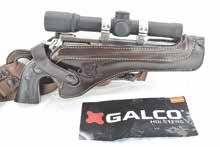
To test this theory, we brought in a Galco Kodiak Hunter KH130H, $167 from OpticsPlanet.com). Our holster provided plenty of the room for the 7.5-inch barrel on the Bisley Hunter. This one was crafted with a deep chocolate brown leather for the holster, tan stitching, and brown nylon straps. The top of the holster (remember it lies almost horizontal across the chest as it is carried) is heavily reinforced to make sure this long scabbard doesn’t fold up on you. The muzzle end is also reinforced, and there is a manual thumb break to make sure things don’t fall out at an inopportune moment.
The unit uses two sets of straps, both with quick-release bayonet clips. One set goes over the shoulder and is comfortably padded. The other goes around the torso to keep the revolver in close to your body as you move. Deer season in Texas can mean temps in the 80s or the 20s, with those extremes sometimes two weeks apart. We don’t always know how much clothing we will be wearing, so we would need sufficient adjustment to accommodate different outerwear, and the Galco Kodiak Hunter provides plenty. Not going hunting? The stainless-steel Bisley Hunter without a scope, carried in the Galco Kodiak Hunter rig, should render yeomen’s service while you fish for salmon in Mr. Kodiak’s home range.
Range Data
| 44 Special HS 240-grain LSWC | Ruger Bisley | Ruger Super Blackhawk |
| Average Velocity | 1028 fps | 1027 fps |
| Muzzle Energy | 568 ft.-lbs. | 566 ft.-lbs. |
| Average Group | 1.09 in. | 1.31 in. |
| Best Group | 0.98 in. | 0.77 in. |
| 44 Magnum HS 240-grain LSWC | Ruger Bisley | Ruger Super Blackhawk |
| Average Velocity | 1326 fps. | 1419 fps |
| Muzzle Energy | 945 ft.-lbs. | 1083 ft.-lbs. |
| Average Group | 1.17 in. | 1.50 in. |
| Best Group | 0.90 in. | 1.28 in. |
| 44 Magnum Speer 240-grain Gold Dot | Ruger Bisley | Ruger Super Blackhawk |
| Average Velocity | 1409 fps | 1377 fps |
| Muzzle Energy | 1058 ft.-lbs. | 1010 ft.-lbs. |
| Average Group | 1.13 in. | 1.15 in. |
| Best Group | 0.78 in. | 0.97 in. |
Testing was done at American Shooting Centers in west Houston. Muzzle velocities were determined via a LabRadar chronograph. All shots for group were done from a well-sandbagged Caldwell Pistol Rest and aided by a mini-DRC Fortune Cookie bag from Wiebad.com.
Drill Data (5x9x10)
| Pistol | Time to First Shot (seconds) | Split Average (seconds) | Total Time (seconds) |
|---|---|---|---|
| Ruger Bisley | 1.06 | 0.71 | 4.08 |
| Ruger Super Blackhawk | 1.31 | 1.05 | 5.51 |



























